Analysis of Genes Associated with Feeding Preference and Detoxification in Various Developmental Stages of Aglais urticae
Abstract
Simple Summary
Abstract
1. Introduction
2. Materials and Methods
2.1. Study Sites and Insect Collections
2.2. A. urticae Larval Odor Selection Behavior Bioassay
2.3. Larval Feeding Choices on Four Plants and Feeding Rates on U. cannabina Behavior Bioassay
2.4. Enzyme Activity Assays of Feeding on Different Plants
2.5. Total RNA Extraction, De Novo Assembly, and Functional Annotation of Transcriptomic Data
2.6. Identification and Analysis of Differentially Expressed Genes
2.7. qRT-PCR Analysis
2.8. Statistical Analysis
3. Results
3.1. Analysis of the Host Plant Selection Behavior of A. urticae Larvae
3.2. Analysis of Feeding Preference of Larvae A. urticae among Four Plants
3.3. Analysis of the Feeding Rate at Different Instars with Different Densities of A. urticae Larvae
3.4. Analysis of the Enzyme Activity Assay
3.5. Transcriptome Sequencing and De Novo Assembly
3.6. Gene Functional Annotation
3.7. Analyses of Differentially Expressed Genes
3.8. Screening for Detoxification Enzyme Genes
3.9. Gene Expression Analyses across the Development Stages of A. urticae
3.10. Identification of the Differentially Expressed Genes (DEGs)
4. Discussion
Supplementary Materials
Author Contributions
Funding
Data Availability Statement
Conflicts of Interest
Abbreviations
References
- Coapio, G.G.; Cruz-López, L.; Guerenstein, P.; Malo, E.A.; Rojas, J.C. Oviposition preference and larval performance and behavior of Trichoplusia ni (Lepidoptera: Noctuidae) on host and nonhost plants. Arthropod-Plant Interact. 2017, 12, 267–276. [Google Scholar] [CrossRef]
- Hu, P.; Li, H.L.; Zhang, H.F.; Luo, Q.W.; Guo, X.R.; Wang, G.P.; Li, W.Z.; Yuan, G. Experience-based mediation of feeding and oviposition behaviors in the cotton bollworm: Helicoverpa armigera (Lepidoptera: Noctuidae). PLoS ONE 2018, 13, e0190401. [Google Scholar] [CrossRef] [PubMed]
- Gong, B.; Zhang, G. Interactions between plants and herbivores: A review of plant defense. Acta Ecol. Sin. 2014, 34, 325–336. [Google Scholar] [CrossRef]
- Zheng, S.; Luo, J.; Zhu, X.; Gao, X.; Hua, H.; Cui, J. Transcriptomic analysis of salivary gland and proteomic analysis of oral secretion in Helicoverpa armigera under cotton plant leaves, gossypol, and tannin stresses. Genomics 2022, 114, 110267. [Google Scholar] [CrossRef] [PubMed]
- Vandewoestijne, S.; Baguette, M.; Brakefield, P.M.; Saccheri, I.J. Phylogeography of Aglais urticae (Lepidoptera) based on DNA sequences of the mitochondrial COI gene and control region. Mol. Phylogenetics Evol. 2004, 31, 630–646. [Google Scholar] [CrossRef]
- Audusseau, H.; Ryrholm, N.; Stefanescu, C.; Tharel, S.; Jansson, C.; Champeaux, L.; Shaw, M.R.; Raper, C.; Lewis, O.T.; Janz, N.; et al. Rewiring of interactions in a changing environment: Nettle-feeding butterflies and their parasitoids. Oikos 2021, 130, 624–636. [Google Scholar] [CrossRef]
- Schapers, A.; Nylin, S.; Carlsson, M.A.; Janz, N. Specialist and generalist oviposition strategies in butterflies: Maternal care or precocious young? Oecologia 2016, 180, 335–343. [Google Scholar] [CrossRef]
- Ensikat, H.J.; Wessely, H.; Engeser, M.; Weigend, M. Distribution, Ecology, Chemistry and Toxicology of Plant Stinging Hairs. Toxins 2021, 13, 141–171. [Google Scholar] [CrossRef]
- Agrawal, A.A.; Zhang, Z.-J.; Zhang, S.-S.; Niu, B.-L.; Ji, D.-F.; Liu, X.-J.; Li, M.-W.; Bai, H.; Palli, S.R.; Wang, C.-Z.; et al. A determining factor for insect feeding preference in the silkworm, Bombyx mori. PLoS Biol. 2019, 17, e3000162. [Google Scholar]
- Zhang, X.Q.; Jiang, C.; Jin, Y.M.; Li, P.; Zhong, J.F. The effect of substitution of mixed grass hay with Urtica cannabina hay and/or Leymus chinensis hay on blood biochemical profile, carcass traits, and intramuscular fatty acid composition in finishing lambs. Anim. Feed Sci. Technol. 2021, 272, 114780. [Google Scholar] [CrossRef]
- Aishan, H.; Baba, M.; Iwasaki, N.; Kuang, H.; Okuyama, T. The constituents of Urtica cannabina used in Uighur medicine. Pharm. Biol. 2010, 48, 577–583. [Google Scholar] [CrossRef] [PubMed]
- Long, W.; Tang, H.; Zhong, X.; Wang, H.; Wang, H. Hypoglycemic and lipid-lowering effects of extracted from the aerial part of Urtica cannabina L. on alloxan-induced hypergl-ycemic mice. IOP Conf. Ser. Earth Environ. Sci. 2020, 512, 012097. [Google Scholar] [CrossRef]
- Audusseau, H.; Ryrholm, N.; Stefanescu, C.; Tharel, S.; Jansson, C.; Champeaux, L.; Shaw, M.R.; Raper, C.; Lewis, O.T.; Janz, N.; et al. Altered parasitism of a butterfly assemblage associated with a range-expanding species. bioRxiv 2020, 14, 947440. [Google Scholar]
- Bryant, S.; Thomas, C.; Bale, J. Nettle-feeding nymphalid butterflies: Temperature, development and distribution. Ecol. Entomol. 1997, 22, 390–398. [Google Scholar] [CrossRef]
- Pullin, A.S.J.O. Changes in Leaf Quality Following Clipping and Regrowth of Urtica dioica, and Consequences for a Specialist Insect Herbivore, Aglais urticae. Oikos 1987, 49, 39–45. [Google Scholar] [CrossRef]
- Pullin, A.S.; Bale, J.S. Effects of low temperature on diapausing Aglais urticae and inachis io (Lepidoptera: Nymphalidae): Cold hardiness and overwintering survival. J. Insect Physiol. 1989, 35, 277–281. [Google Scholar] [CrossRef]
- Knolhoff, L.M.; Heckel, D.G. Behavioral assays for studies of host plant choice and adaptation in herbivorous insects. Annu. Rev. Entomol. 2014, 59, 263–278. [Google Scholar] [CrossRef]
- Khan, F.A.; Anis, S.B.; Badruddin, S.M. Plant defenses against insect herbivory. Integr. Manag. Arthropod Pests Insect Borne Dis. 2010, 2010, 189–208. [Google Scholar]
- Yang, J.; Guo, H.; Jiang, N.J.; Tang, R.; Li, G.C.; Huang, L.Q.; Loon, J.J.A.; Wang, C.Z. Identification of a gustatory receptor tuned to sinigrin in the cabbage butterfly Pieris rapae. PLoS Genet. 2021, 17, e1009527. [Google Scholar] [CrossRef]
- Haan, N.L.; Bowers, M.D.; Bakker, J.D. Preference, performance, and chemical defense in an endangered butterfly using novel and ancestral host plants. Sci. Rep. 2021, 11, 992–1008. [Google Scholar] [CrossRef]
- Nallu, S.; Hill, J.A.; Don, K.; Sahagun, C.; Zhang, W.; Meslin, C.; Snell-Rood, E.; Clark, N.L.; Morehouse, N.I.; Bergelson, J.; et al. The molecular genetic basis of herbivory between butterflies and their host plants. Nat. Ecol. Evol. 2018, 2, 1418–1427. [Google Scholar] [CrossRef] [PubMed]
- Simon, S.; Breeschoten, T.; Jansen, H.J.; Dirks, R.P.; Schranz, M.E.; Ros, V.I.D. Genome and transcriptome analysis of the beet armyworm Spodoptera exigua reveals targets for pest control. G3 2021, 11, jkab311. [Google Scholar] [CrossRef] [PubMed]
- Li, F.; Zhao, X.; Li, M.; He, K.; Huang, C.; Zhou, Y.; Li, Z.; Walters, J.R. Insect genomes: Progress and challenges. Insect Mol. Biol. 2019, 28, 739–758. [Google Scholar] [CrossRef] [PubMed]
- Jia, Z.Q.; Liu, D.; Peng, Y.C.; Han, Z.J.; Zhao, C.Q.; Tang, T. Identification of transcriptome and fluralaner responsive genes in the common cutworm Spodoptera litura Fabricius, based on RNA-seq. BMC Genom. 2020, 21, 120. [Google Scholar] [CrossRef] [PubMed]
- Yan, J.; Yu, L.; Xuan, J.; Lu, Y.; Lu, S.; Zhu, W. De novo transcriptome sequencing and gene expression profiling of spinach (Spinacia oleracea L.) leaves under heat stress. Sci. Rep. 2016, 6, 19473. [Google Scholar] [CrossRef] [PubMed]
- Yan, F.; Zhu, Y.; Zhao, Y.; Wang, Y.; Li, J.; Wang, Q.; Liu, Y. De novo transcriptome sequencing and analysis of salt-, alkali-, and drought-responsive genes in Sophora alopecuroides. BMC Genom. 2020, 21, 423. [Google Scholar] [CrossRef] [PubMed]
- Zhang, T.; He, K.; Wang, Z. Transcriptome comparison analysis of Ostrinia furnacalis in four developmental stages. Sci. Rep. 2016, 6, 35008. [Google Scholar] [CrossRef]
- Guo, Y.; Chai, Y.; Zhang, L.; Zhao, Z.; Gao, L.L.; Ma, R. Transcriptome analysis and identification of major detoxification gene families and insecticide targets in Grapholita Molesta (Busck) (Lepidoptera: Tortricidae). J. Insect Sci. 2017, 17, 43. [Google Scholar] [CrossRef]
- Love, M.I.; Huber, W.; Anders, S. Moderated estimation of fold change and dispersion for RNA-seq data with DESeq2. Genome Biol. 2014, 15, 550. [Google Scholar] [CrossRef]
- Dillies, M.A.; Rau, A.; Aubert, J.; Hennequet, A.C.; Jeanmougin, M.; Servant, N.; Keime, C.; Marot, G.; Castel, D.; Estelle, J.; et al. A comprehensive evaluation of normalization methods for Illumina high-throughput RNA sequencing data analysis. Brief. Bioinform. 2013, 14, 671–683. [Google Scholar] [CrossRef]
- Young, M.D.; Wakefield, M.J.; Smyth, G.K.; Oshlack, A. Gene ontology analysis for RNA-seq: Accounting for selection bias. Genome Biol. 2010, 11, R14. [Google Scholar] [CrossRef] [PubMed]
- Mao, X.; Cai, T.; Olyarchuk, J.G.; Wei, L. Automated genome annotation and pathway identification using the KEGG Orthology (KO) as a controlled vocabulary. Bioinformatics 2005, 21, 3787–3793. [Google Scholar] [CrossRef] [PubMed]
- Waardenberg, A.J.; Field, M.A. consensusDE: An R package for assessing consensus of multiple RNA-seq algorithms with RUV correction. PeerJ 2019, 7, e8206. [Google Scholar] [CrossRef] [PubMed]
- Grabherr, M.G.; Haas, B.J.; Yassour, M.; Levin, J.Z.; Thompson, D.A.; Amit, I.; Adiconis, X.; Fan, L.; Raychowdhury, R.; Zeng, Q.; et al. Full-length transcriptome assembly from RNA-Seq data without a reference genome. Nat. Biotechnol. 2011, 29, 644–652. [Google Scholar] [CrossRef] [PubMed]
- Jauhal, A.A.; Newcomb, R.D. Assessing genome assembly quality prior to downstream analysis: N50 versus BUSCO. Mol. Ecol. Resour. 2021, 5, 1416–1421. [Google Scholar] [CrossRef]
- Zhao, J.; Wei, Q.; Gu, X.R.; Ren, S.W.; Liu, X.N. Alcohol dehydrogenase 5 of Helicoverpa armigera interacts with the CYP6B6 promoter in response to 2-tridecanone. Insect Sci. 2020, 27, 1053–1066. [Google Scholar] [CrossRef]
- Andersson, S. Foraging responses in the butterflies Inachis io, Aglais urticae (Nymphalidae), and Gonepteryx rhamni (Pieridae) to floral scents. Chemoecology 2003, 13, 1–11. [Google Scholar] [CrossRef]
- Rodrigues, D.; Moreira, G.R.P. Seasonal variation in larval host plants and consequences for Heliconius erato (Lepidoptera: Nymphalidae) adult body size. Austral Ecol. 2004, 29, 437–445. [Google Scholar] [CrossRef]
- Tiwari, R.; Rana, C.S. Plant secondary metabolites: A review. Int. J. Eng. Res. Gen. Sci. 2015, 3, 661–670. [Google Scholar]
- Divekar, P.A.; Narayana, S.; Divekar, B.A.; Kumar, R.; Gadratagi, B.G.; Ray, A.; Singh, A.K.; Rani, V.; Singh, V.; Singh, A.K.; et al. Plant secondary metabolites as defense tools against herbivores for sustainable crop protection. Int. J. Mol. Sci. 2022, 23, 2690. [Google Scholar] [CrossRef]
- Zhong, H.; Li, F.; Chen, J.; Zhang, J.; Li, F. Comparative transcriptome analysis reveals host-associated differentiation in Chilo suppressalis (Lepidoptera: Crambidae). Sci. Rep. 2017, 7, 13778. [Google Scholar] [CrossRef] [PubMed]
- Huang, Y.; Liao, M.; Yang, Q.; Xiao, J.; Hu, Z.; Zhou, L.; Cao, H. Transcriptome profiling reveals differential gene expression of detoxification enzymes in Sitophilus zeamais responding to terpinen-4-ol fumigation. Pestic. Biochem. Physiol. 2018, 149, 44–53. [Google Scholar] [CrossRef] [PubMed]
- Barth, M.B.; Buchwalder, K.; Kawahara, A.Y.; Zhou, X.; Liu, S.; Krezdorn, N.; Rotter, B.; Horres, R.; Hundsdoerfer, A.K. Functional characterization of the Hyles euphorbiae hawkmoth transcriptome reveals strong expression of phorbol ester detoxification and seasonal cold hardiness genes. Front. Zool. 2018, 15, 20. [Google Scholar] [CrossRef]
- Wu, C.; Chakrabarty, S.; Jin, M.; Liu, K.; Xiao, Y. Insect ATP-Binding Cassette (ABC) Transporters: Roles in xenobiotic detoxification and Bt insecticidal activity. Int. J. Mol. Sci. 2019, 20, 2829. [Google Scholar] [CrossRef] [PubMed]
- Chen, L.; Wei, J.; Liu, C.; Zhang, W.; Wang, B.; Niu, L.; Liang, G. Specific Binding Protein ABCC1 Is Associated with Cry2Ab Toxicity in Helicoverpa armigera. Front. Physiol. 2018, 9, 745. [Google Scholar] [CrossRef] [PubMed]
- Wang, Z.; Tian, F.; Cai, L.; Zhang, J.; Liu, J.; Zeng, X. Identification of candidate ATP-binding cassette transporter gene family members in Diaphorina citri (Hemiptera: Psyllidae) via adult tissues transcriptome analysis. Sci. Rep. 2019, 9, 15842. [Google Scholar] [CrossRef]
- Tian, L.; Song, T.; He, R.; Zeng, Y.; Xie, W.; Wu, Q.; Wang, S.; Zhou, X.; Zhang, Y. Genome-wide analysis of ATP-binding cassette (ABC) transporters in the sweetpotato whitefly, Bemisia tabaci. BMC Genom. 2017, 18, 330. [Google Scholar] [CrossRef]
- Chen, H.; Xie, M.; Lin, L.; Zhong, Y.; Zhang, F.; Su, W. Transcriptome Analysis of detoxification-related genes in Spodoptera frugiperda (Lepidoptera: Noctuidae). J. Insect Sci. 2022, 22, 11. [Google Scholar] [CrossRef]
- Tan, W.H.; Acevedo, T.; Harris, E.V.; Alcaide, T.Y.; Walters, J.R.; Hunter, M.D.; Gerardo, N.M.; De Roode, J.C. Transcriptomics of monarch butterflies (Danaus plexippus) reveals that toxic host plants alter expression of detoxification genes and down-regulate a small number of immune genes. Mol. Ecol. 2019, 28, 4845–4863. [Google Scholar] [CrossRef]
- Pandhair, V.; Sekhon, B.S. Reactive oxygen species and antioxidants in plants: An overview. J. Plant Biochem. Biotechnol. 2006, 15, 71–78. [Google Scholar] [CrossRef]
- Zhang, S.Z.; Huang, H.; Shan, H.W.; Zhang, F.; Wan, F.H.; Liu, T.X. Defense against Pieris rapaein cabbage plants induced by Bemisia tabacibiotype. Entomol. Exp. Et Appl. 2013, 147, 293–300. [Google Scholar] [CrossRef]
- Carneiro, E.; Kafer, J.M.; Gobatto, D.R.; Fedrigo, K.; Andrade, G.S.; de Oliveira Vargas, T.F.T. Morphogenetic analysis of common bean genotypes in response to Diabrotica speciosa (Germar, 1824) (Coleoptera: Chrysomelidae). Arthropod-Plant Interact. 2022, 16, 477–493. [Google Scholar] [CrossRef]
- Muhammad, A.; He, J.; Yu, T.; Sun, C.; Shi, D.; Jiang, Y.; Xianyu, Y.; Shao, Y. Dietary exposure of copper and zinc oxides nanoparticles affect the fitness, enzyme activity, and microbial community of the model insect, silkworm Bombyx mori. Sci. Total Environ. 2022, 813, 152608. [Google Scholar] [CrossRef] [PubMed]
- Manjula, P.; Lalitha, K.; Vengateswari, G.; Patil, J.; Nathan, S.S.; Shivakumar, M.S. Effect of Manihot esculenta (Crantz) leaf extracts on antioxidant and immune system of Spodoptera litura (Lepidoptera: Noctuidae). Biocatal. Agric. Biotechnol. 2020, 23, 101476. [Google Scholar] [CrossRef]
- Shonte, T.T.; Duodu, K.G.; de Kock, H.L. Effect of drying methods on chemical composition and antioxidant activity of underutilized stinging nettle leaves. Heliyon 2020, 6, e03938. [Google Scholar] [CrossRef] [PubMed]
- Bhusal, K.K.; Magar, S.K.; Thapa, R.; Lamsal, A.; Bhandari, S.; Maharjan, R.; Shrestha, S.; Shrestha, J. Nutritional and pharmacological importance of stinging nettle (Urtica dioica L.): A review. Heliyon 2022, 8, e09717. [Google Scholar] [CrossRef]
- James, D.G.; Lauby, G.; Seymour, L.; Buckley, K. Beneficial insects associated with stinging nettle, Urtica dioica Linnaeus, in central Washington State. Pan-Pac. Entomol. 2015, 91, 82–90. [Google Scholar] [CrossRef]
- Schäpers, A.; Carlsson, M.A.; Gamberale, S.G.; Janz, N. The role of olfactory cues for the search behavior of a specialist and generalist butterfly. J. Insect Behav. 2015, 28, 77–87. [Google Scholar] [CrossRef]
- Huang, G.H.; Sun, Z.L.; Li, H.J.; Feng, D.F. Rho GTPase-activating proteins: Regulators of Rho GTPase activity in neuronal development and CNS diseases. Mol. Cell. Neurosci. 2017, 80, 18–31. [Google Scholar] [CrossRef]
- Rosser, M.F.; Washburn, E.; Muchowski, P.J.; Patterson, C.; Cyr, D.M. Chaperone functions of the E3 ubiquitin ligase CHIP. J. Biol. Chem. 2007, 282, 22267–22277. [Google Scholar] [CrossRef]
- De, J.C.; Bataille, L.; Jagla, T.K. Diversification of muscle types in Drosophila: Upstream and downstream of identity genes. Curr. Top. Dev. Biol. 2012, 98, 277–301. [Google Scholar]
- Kotarski, M.A.; Leonard, D.A.; Bennett, S.A.; Bishop, C.P.; Wahn, S.D.; Sedore, S.A.; Shrader, M. The Drosophila gene asteroid encodes a novel protein and displays dosage-sensitive interactions with Star and Egfr. Genome 1998, 41, 295–302. [Google Scholar] [CrossRef]
- Suksuwan, W.; Cai, X.; Ngernsiri, L.; Baumgartner, S. Segmentation gene expression patterns in Bactrocera dorsalis and related insects: Regulation and shape of blastoderm and larval cuticle. Int. J. Dev. Biol. 2017, 61, 439–450. [Google Scholar] [CrossRef] [PubMed]
- Doctor, J.; Fristrom, D.; Fristrom, J.W. The pupal cuticle of Drosophila: Biphasic synthesis of pupal cuticle proteins in vivo and in vitro in response to 20-hydroxyecdysone. J. Cell Biol. 1985, 101, 189–200. [Google Scholar] [CrossRef] [PubMed]
- Chen, J.; Zou, X.; Zhu, W.; Duan, Y.; Merzendorfer, H.; Zhao, Z.; Yang, Q. Fatty acid binding protein is required for chitin biosynthesis in the wing of Drosophila melanogaster. Insect Biochem. Mol. Biol. 2022, 149, 1038–1045. [Google Scholar] [CrossRef] [PubMed]
- Zhang, B.; Yao, B.; Li, X.; Jing, T.; Zhang, S.; Zou, H.; Zhang, G.; Zou, C. E74 knockdown represses larval development and chitin synthesis in Hyphantria cunea. Pestic. Biochem. Physiol. 2022, 187, 105216. [Google Scholar] [CrossRef]
- Hu, J.; Wang, Y.; Le, Q.; Yu, N.; Cao, X.; Kuang, S.; Zhang, M.; Gu, W.; Sun, Y.; Yang, Y.; et al. Transcriptome sequencing of olfactory-related genes in olfactory transduction of large yellow croaker (Larimichthy crocea) in response to bile salts. PeerJ 2019, 7, e6627. [Google Scholar] [CrossRef]
- Lohr, C.; Bergstein, S.; Hirnet, D. Developmental distribution of CaM kinase II in the antennal lobe of the sphinx moth Manduca sexta. Cell Tissue Res. 2007, 327, 189–197. [Google Scholar] [CrossRef]
- Pezier, A.; Grauso, M.; Acquistapace, A.; Monsempes, C.; Rospars, J.P.; Lucas, P. Calcium activates a chloride conductance likely involved in olfactory receptor neuron repolarization in the moth Spodoptera littoralis. J. Neurosci. 2010, 30, 6323–6333. [Google Scholar] [CrossRef]
- Liu, X.; Davis, R.L. Insect olfactory memory in time and space. Curr. Opin. Neurobiol. 2006, 16, 679–685. [Google Scholar] [CrossRef]
- Bönigk, W.; Bradley, J.; Müller, F.; Sesti, F.; Boekhoff, I.; Ronnett, G.V.; Kaupp, U.B.; Frings, S. The native rat olfactory cyclic nucleotide-gated channel is composed of three distinct subunits. J. Neurosci. 1999, 19, 5332–5347. [Google Scholar] [CrossRef] [PubMed]
- O’Halloran, D.M.; Altshuler-Keylin, S.; Zhang, X.D.; He, C.; Morales, P.C.; Yu, Y.; Kaye, J.A.; Brueggemann, C.; Chen, T.Y.; L’Etoile, N.D. Contribution of the cyclic nucleotide gated channel subunit, CNG-3, to olfactory plasticity in Caenorhabditis elegans. Sci. Rep. 2017, 7, 169. [Google Scholar] [CrossRef] [PubMed]
- Zheng, J.; Zagotta, W.N. Stoichiometry and assembly of olfactory cyclic nucleotide-gated channels. Neuron 2004, 42, 411–421. [Google Scholar] [CrossRef] [PubMed]
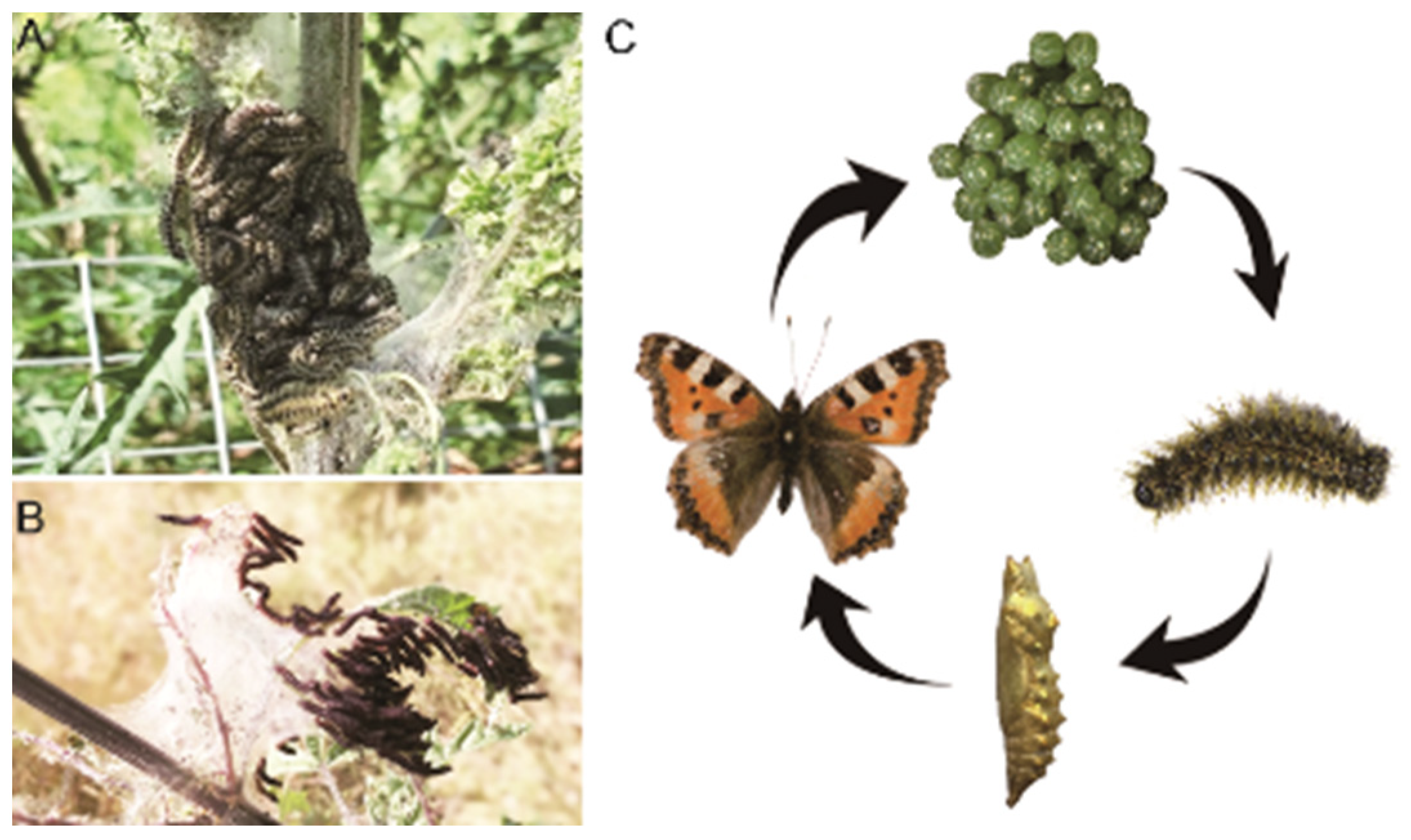

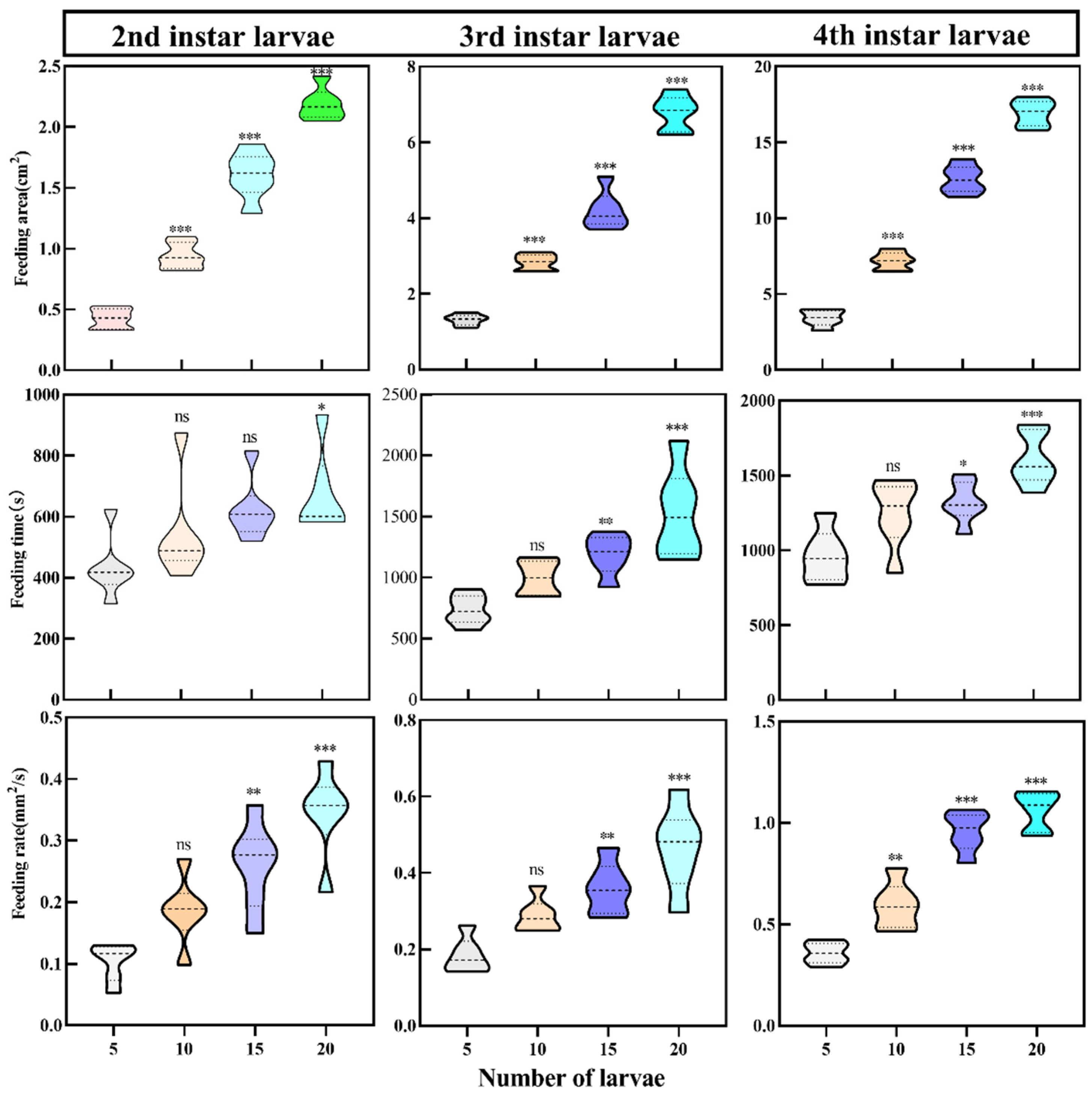

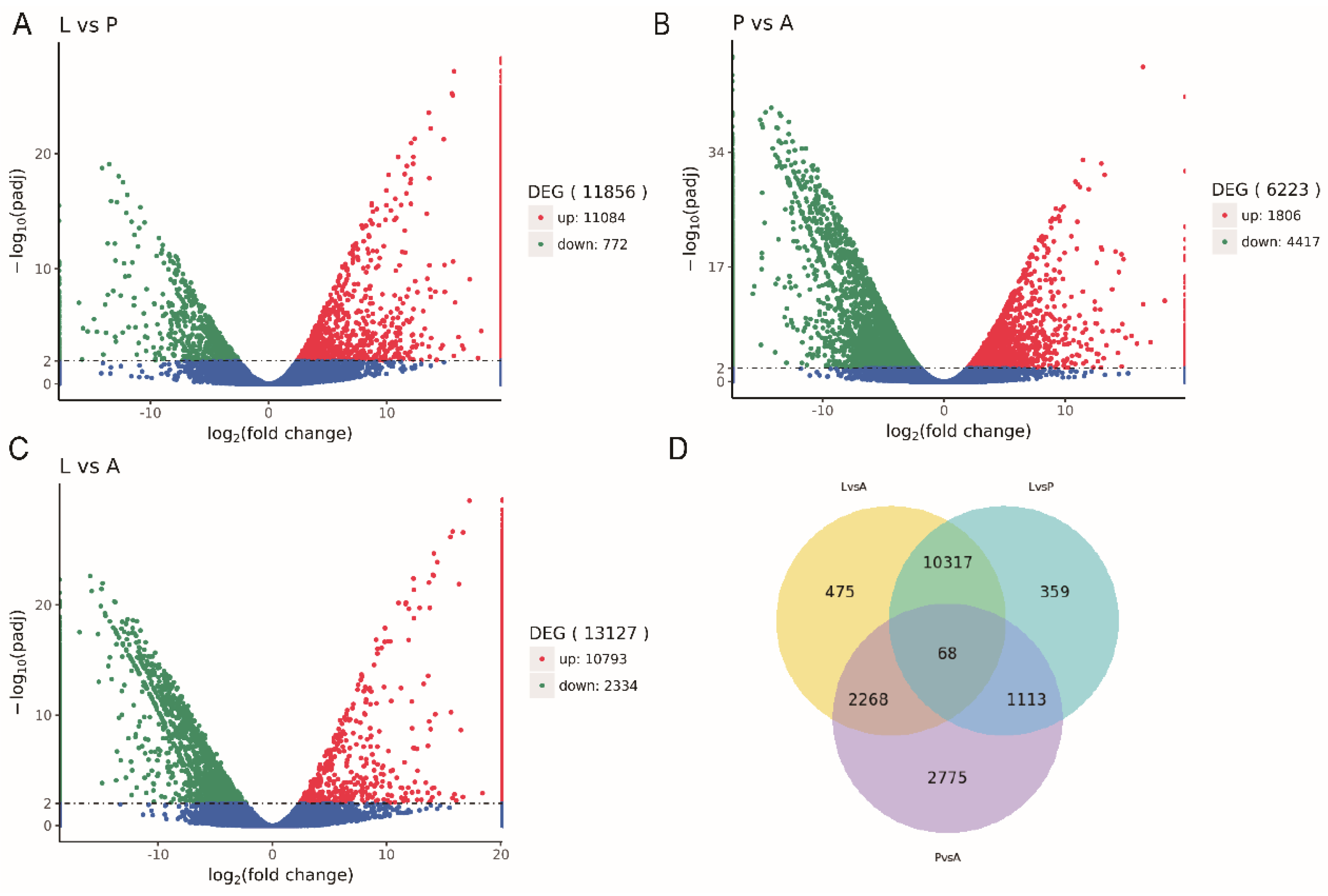
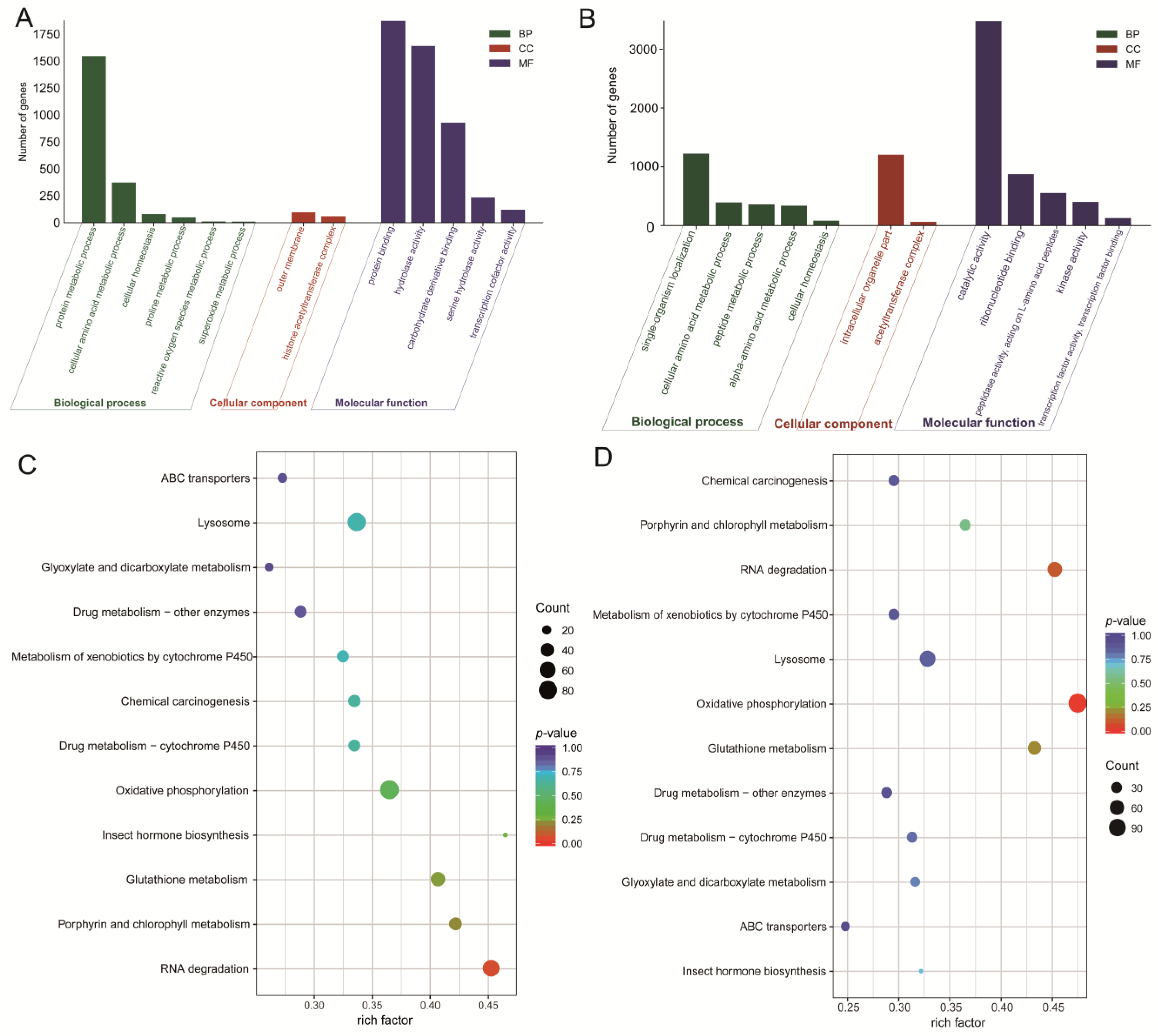
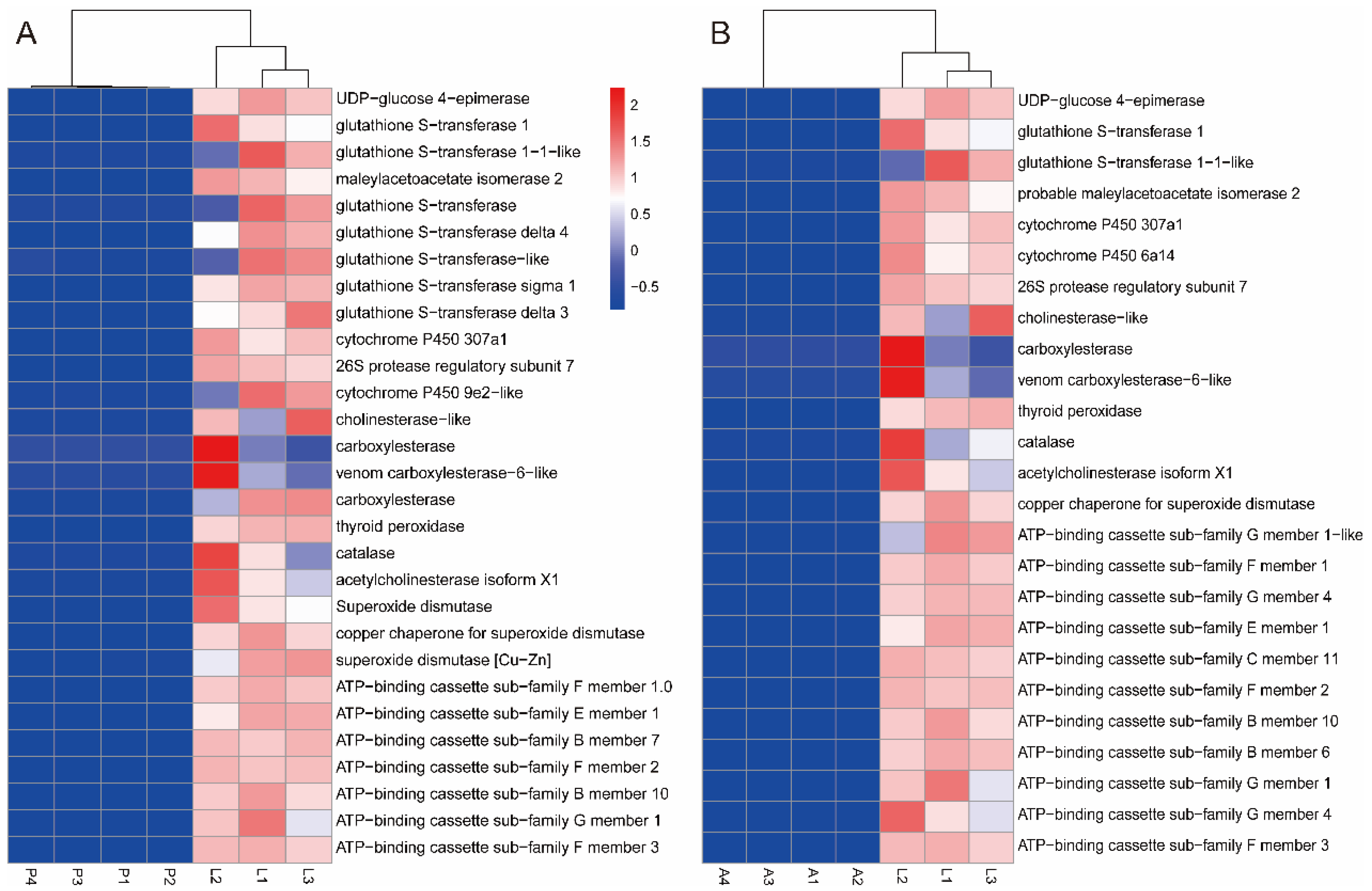
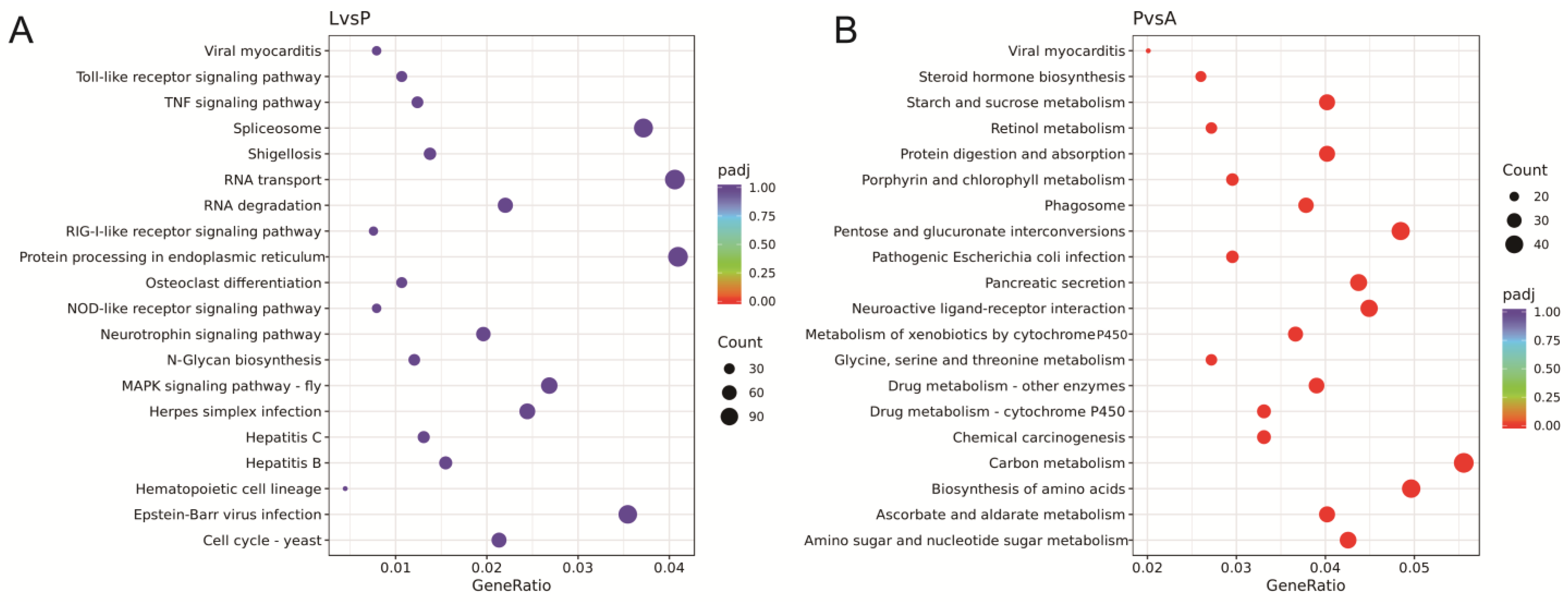
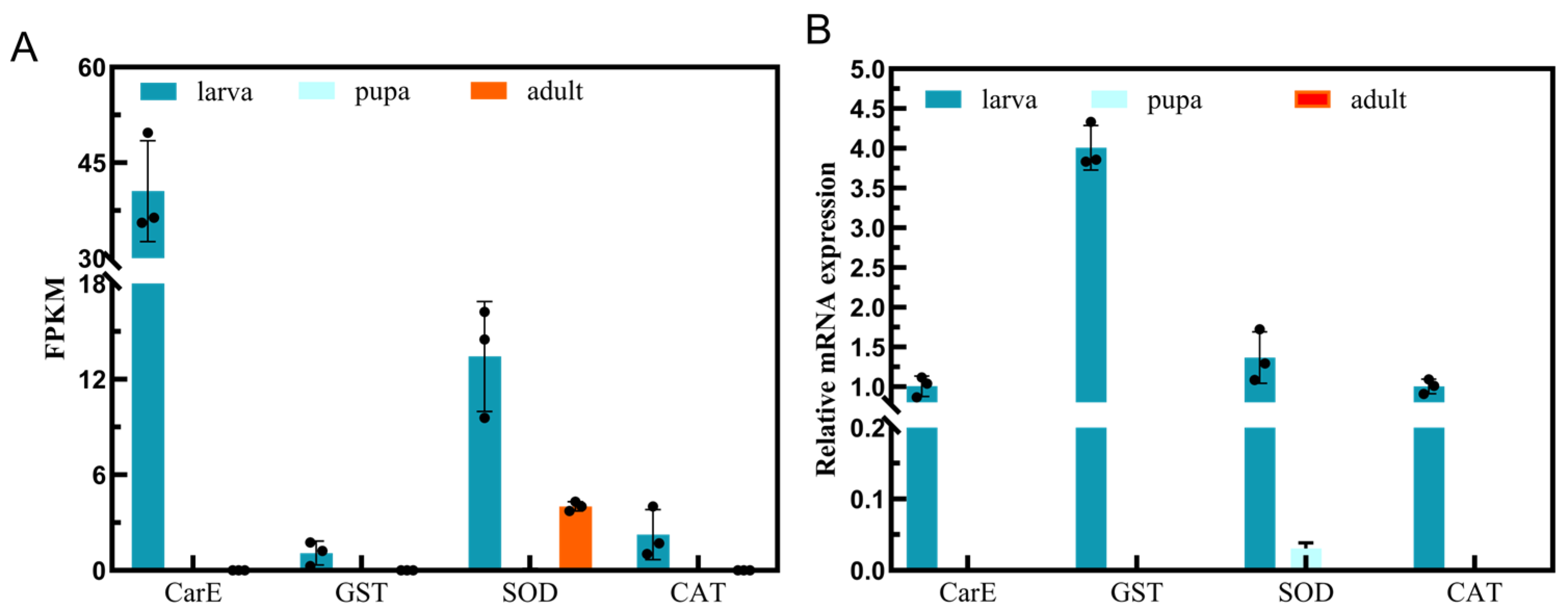
| Sample | Raw Reads | Clean Reads | Error Rate (%) | Q20 (%) | Q30 (%) | GC (%) |
|---|---|---|---|---|---|---|
| L1 | 23,070,192 | 22,090,523 | 0.03 | 96.38 | 90.67 | 43.24 |
| L2 | 23,274,479 | 22,478,655 | 0.03 | 96.37 | 90.98 | 41.92 |
| L3 | 23,030,626 | 22,233,626 | 0.03 | 96.93 | 91.87 | 42.48 |
| P1 | 22,264,683 | 21,031,052 | 0.03 | 97.29 | 92.5 | 43.52 |
| P2 | 22,524,081 | 21,926,996 | 0.03 | 97.26 | 92.43 | 45.26 |
| P3 | 22,754,615 | 22,329,792 | 0.03 | 97.15 | 92.35 | 44.34 |
| P4 | 23,235,468 | 22,936,653 | 0.03 | 96.81 | 91.82 | 45.27 |
| A1 | 23,843,502 | 23,226,075 | 0.03 | 96.2 | 90.66 | 42.19 |
| A2 | 49,362,889 | 48,037,771 | 0.03 | 97.55 | 93.21 | 42.53 |
| A3 | 23,102,754 | 22,541,196 | 0.03 | 96.9 | 91.92 | 41.39 |
| A4 | 23,441,887 | 22,809,703 | 0.03 | 96.72 | 91.61 | 42.41 |
| Type | Min Length | Mean Length | Median Length | Max Length | N50 | N90 | Total Nucleotides |
|---|---|---|---|---|---|---|---|
| Transcripts | 301 | 1376 | 828 | 28,639 | 2183 | 562 | 267,694,552 |
| Unigenes | 301 | 1208 | 666 | 28,639 | 1999 | 469 | 93,760,628 |
| Database | Unigenes | Percentage (%) |
|---|---|---|
| Annotated in NR | 30,550 | 39.35 |
| Annotated in NT | 32,045 | 41.28 |
| Annotated in KO | 14,361 | 18.5 |
| Annotated in SwissProt | 19,479 | 25.09 |
| Annotated in PFAM | 21,916 | 28.23 |
| Annotated in GO | 21,914 | 28.23 |
| Annotated in KOG | 11,543 | 14.87 |
| Annotated in all Databases | 6804 | 8.76 |
| Annotated in at least one Database | 41,677 | 53.69 |
| Total Unigenes | 77,624 | 100 |
| GO ID | GO Name | GO Category | Up | Down | p-Value |
|---|---|---|---|---|---|
| GO:0005672 | transcription factor TFIIA complex | CC | 60 | 5 | 2.01 × 10−11 |
| GO:0090575 | RNA polymerase II transcription factor complex | CC | 68 | 5 | 1.92 × 10−10 |
| GO:0044798 | nuclear transcription factor complex | CC | 69 | 5 | 4.61 × 10−10 |
| GO:0016591 | DNA-directed RNA polymerase II | CC | 76 | 5 | 9.06 × 10−10 |
| GO:0019538 | protein metabolic process | BP | 1499 | 47 | 1.31 × 10−9 |
| GO:0000428 | DNA-directed RNA polymerase complex | CC | 87 | 5 | 1.44 × 10−9 |
| GO:0055029 | nuclear DNA-directed RNA polymerase complex | CC | 87 | 5 | 1.44 × 10−9 |
| GO:0008061 | chitin binding | MF | 60 | 18 | 7.51 × 10−9 |
| GO:0044428 | nuclear part | CC | 477 | 14 | 1.54 × 10−8 |
| GO:0000124 | SAGA complex | CC | 41 | 0 | 2.94 × 10−8 |
| GO ID | GO Name | GO Category | Up | Down | p-Value |
|---|---|---|---|---|---|
| GO:0004252 | serine-type endopeptidase activity | MF | 95 | 22 | 5.11 × 10−17 |
| GO:0008236 | serine-type peptidase activity | MF | 106 | 24 | 7.49 × 10−13 |
| GO:0017171 | serine hydrolase activity | MF | 106 | 24 | 7.49 × 10−13 |
| GO:0008061 | chitin binding | MF | 15 | 32 | 5.11 × 10−12 |
| GO:0042302 | structural constituent of cuticle | MF | 7 | 44 | 5.23 × 10−12 |
| GO:0016491 | oxidoreductase activity | MF | 208 | 70 | 1.58 × 10−10 |
| GO:0055114 | oxidation-reduction process | BP | 209 | 69 | 3.19 × 10−9 |
| GO:0005506 | iron ion binding | MF | 60 | 8 | 7.93 × 10−9 |
| GO:0016705 | oxidoreductase activity, acting on paired donors, with incorporation or reduction of molecular oxygen | MF | 51 | 11 | 1.65 × 10−7 |
| GO:0020037 | heme binding | MF | 50 | 9 | 5.36 × 10−7 |
Disclaimer/Publisher’s Note: The statements, opinions and data contained in all publications are solely those of the individual author(s) and contributor(s) and not of MDPI and/or the editor(s). MDPI and/or the editor(s) disclaim responsibility for any injury to people or property resulting from any ideas, methods, instructions or products referred to in the content. |
© 2024 by the authors. Licensee MDPI, Basel, Switzerland. This article is an open access article distributed under the terms and conditions of the Creative Commons Attribution (CC BY) license (https://creativecommons.org/licenses/by/4.0/).
Share and Cite
Xi, O.; Guo, W.; Hu, H. Analysis of Genes Associated with Feeding Preference and Detoxification in Various Developmental Stages of Aglais urticae. Insects 2024, 15, 30. https://doi.org/10.3390/insects15010030
Xi O, Guo W, Hu H. Analysis of Genes Associated with Feeding Preference and Detoxification in Various Developmental Stages of Aglais urticae. Insects. 2024; 15(1):30. https://doi.org/10.3390/insects15010030
Chicago/Turabian StyleXi, Ouyan, Wentao Guo, and Hongying Hu. 2024. "Analysis of Genes Associated with Feeding Preference and Detoxification in Various Developmental Stages of Aglais urticae" Insects 15, no. 1: 30. https://doi.org/10.3390/insects15010030
APA StyleXi, O., Guo, W., & Hu, H. (2024). Analysis of Genes Associated with Feeding Preference and Detoxification in Various Developmental Stages of Aglais urticae. Insects, 15(1), 30. https://doi.org/10.3390/insects15010030






